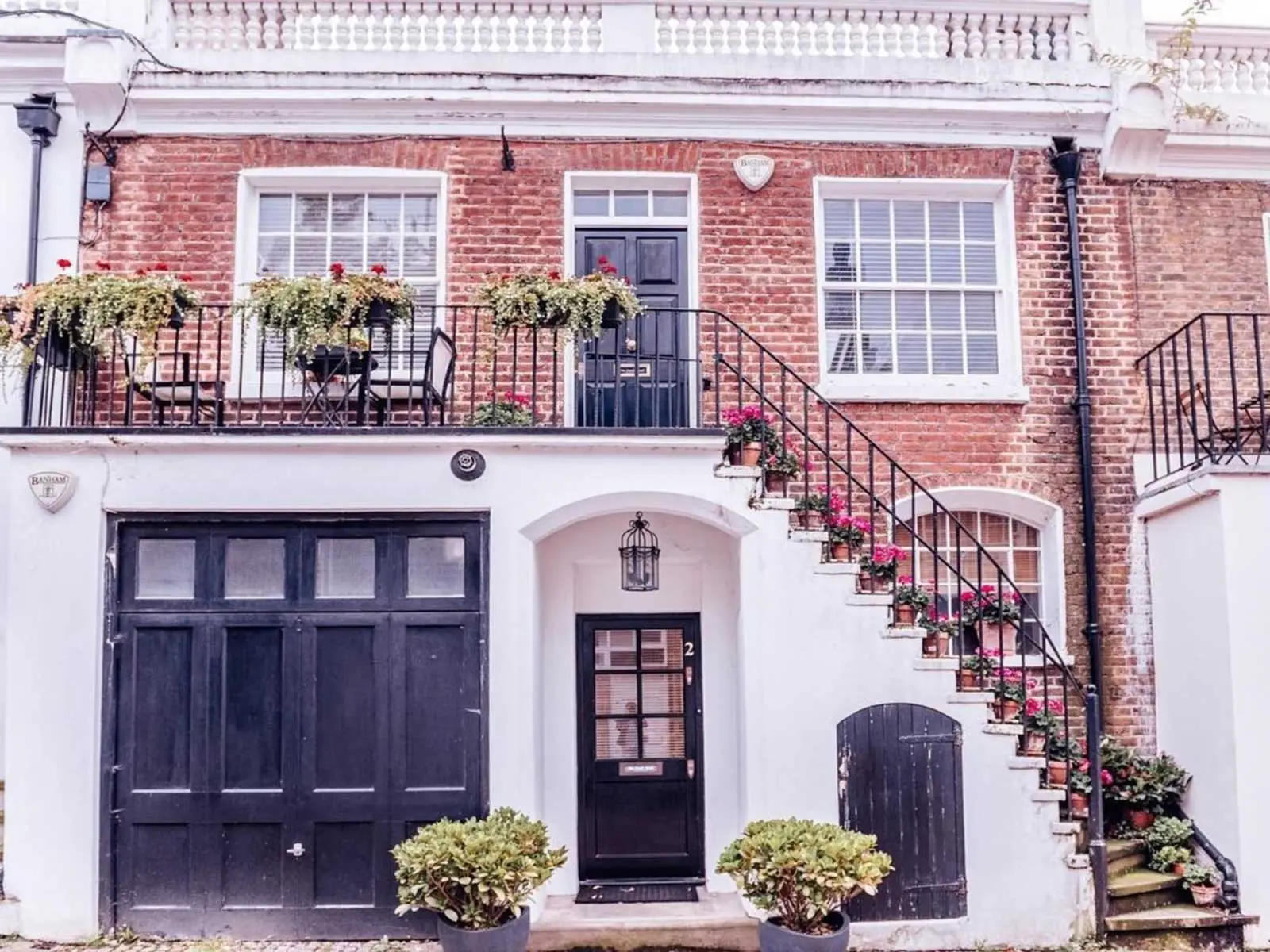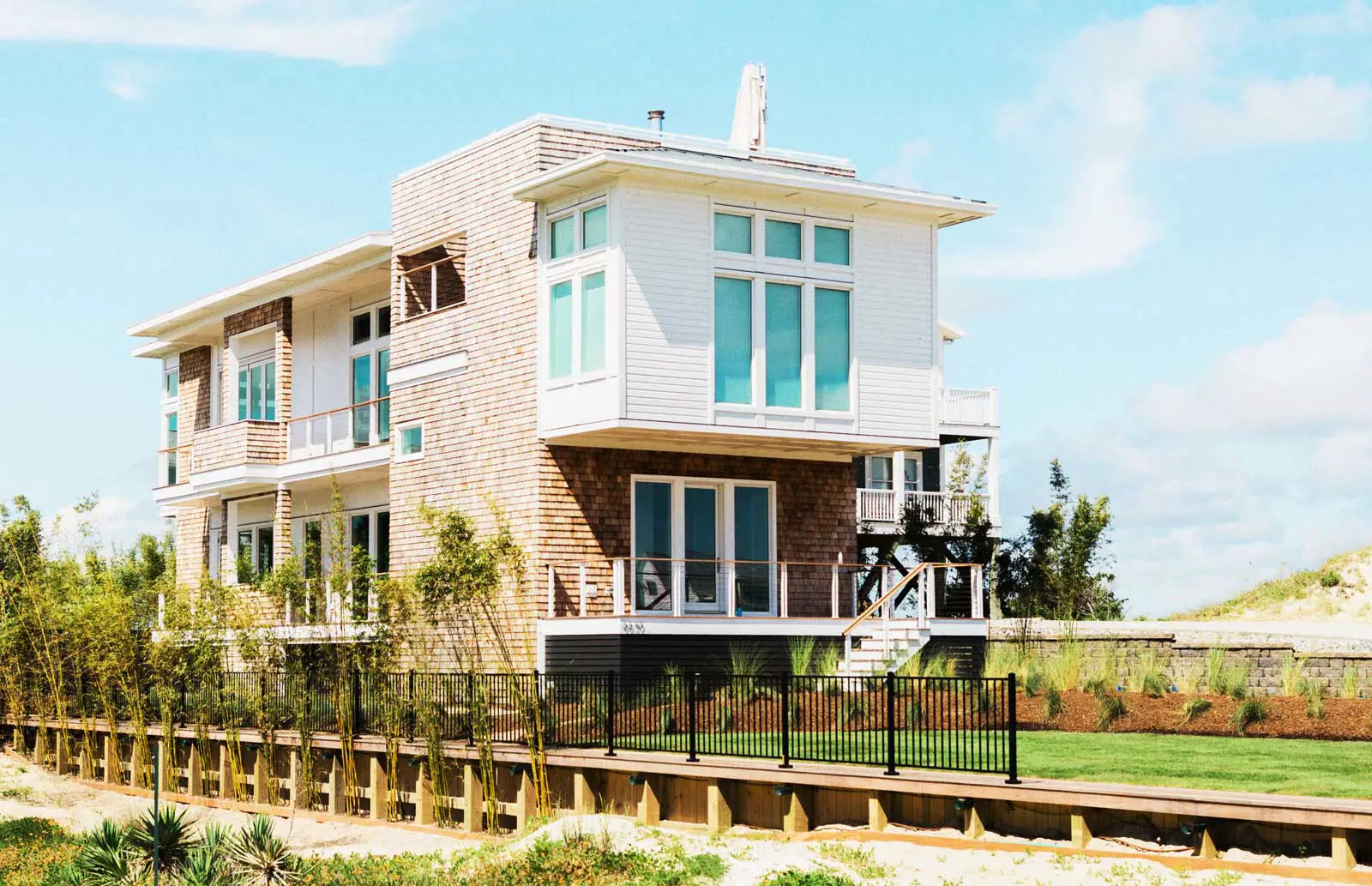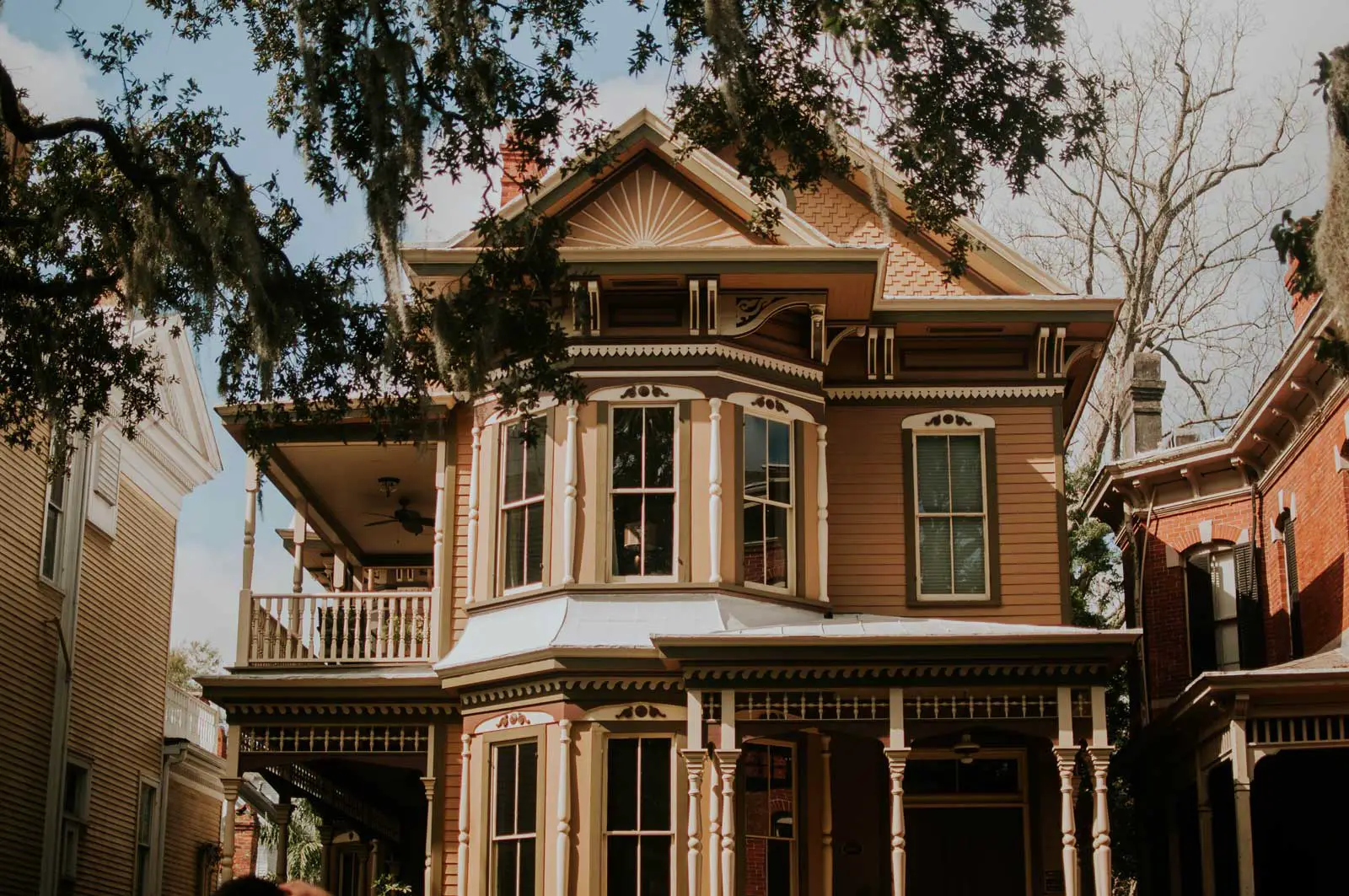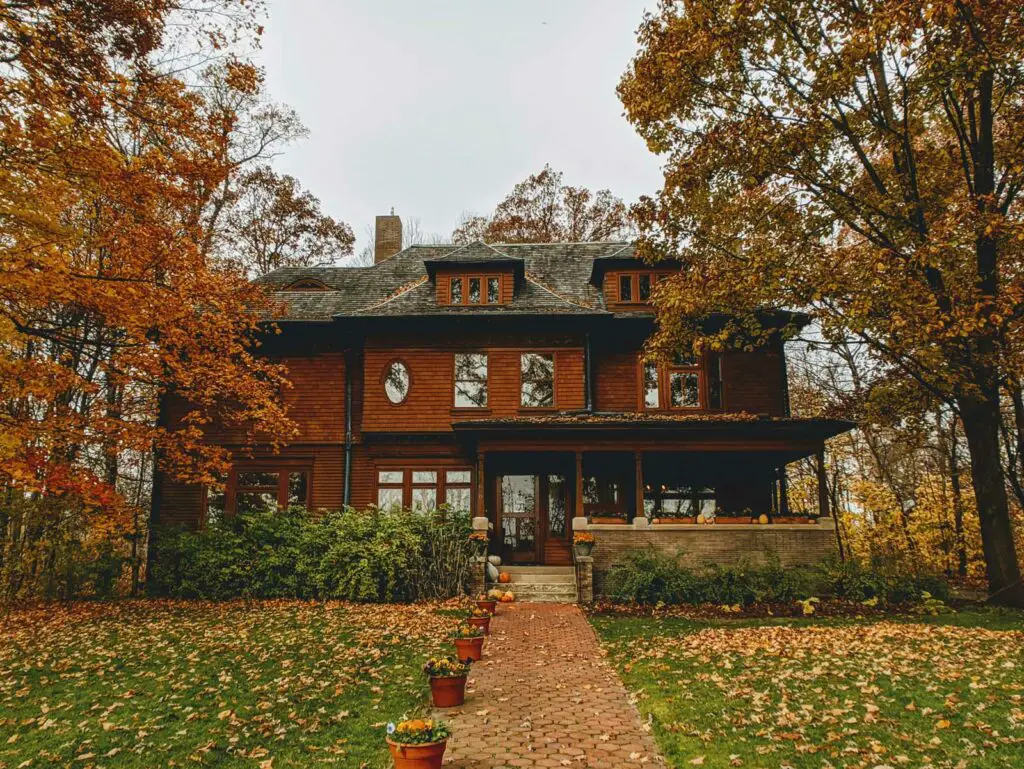Have you ever wondered just how tall a two-story house really is? It seems like a pretty basic question, right? However the answer is anything but straightforward. There are a whole host of factors that can impact the height of a two-story house, from the architectural style to the location and materials used in its construction.
But on average, how tall is a two story house?
A two-story house is typically around 20-25 feet tall or 6-7.6 meters. However, the height can vary depending on factors such as the type of roof, height of the first floor, and thickness of the flooring. Each story in a two-story house usually has a height of 8-9 feet or 2.4-2.7 meters.
In this blog post, we’ll explore the variety of different factors that can influence the height of a two-story house. From the classic gable and hip styles to the more modern flat and mansard designs, we’ll take a deep dive into the world of architectural design and uncover the secrets behind some of the most popular house styles.
But that’s not all – we’ll also look at the practical considerations that go into remodeling or renovating a two-story house, including the impact of local building codes and the cost of materials.
By the way – before we get too far along here, if you want to connect with other homeowners and builders and get more great ideas for your home to make your space the best join my free private Facebook group, Remodel Reality here.
 Average Height of a Two-Story House
Average Height of a Two-Story House
Determining the average height of a two-story house can be a little tricky since because there really is no “one-size-fits-all” answer, there are a lot of variables that come into play.
That said, in general, the average height of a two-story house is around 20 feet or ~6 meters tall. This height can vary depending on a few factors, such as the type of roof, the height of the first floor, and the thickness of the flooring.
| Roof Design | One-Story House (ft) | One-Story House (m) | Two-Story House (ft) | Two-Story House (m) |
|---|---|---|---|---|
| Gable | 18-28 | 5.5-8.5 | 25-36 | 7.6-11 |
| Hip | 20-32 | 6.1-9.8 | 28-44 | 8.5-13.4 |
| Shed | 10-20 | 3-6.1 | 15-25 | 4.6-7.6 |
| Mansard | 23-34 | 7-10.4 | 34-48 | 10.4-14.6 |
| Flat | 10-15 | 3-4.6 | 10-20 | 3-6.1 |
| Gambrel | 18-30 | 5.5-9.1 | 26-36 | 7.9-11 |
What is the height of each floor in a two-story house?
In a two-story house, each floor typically has a height of 8 to 9 feet or 2.4 to 2.7 meters. However, some homes may have ceilings that may be taller or shorter than this average range. When you’re calculating the total height of a two-story house, it is important to take into account the height of each floor and any additional factors that may affect the height.
What is the height of the first floor in a two-story house?
ou’d think that they’d automatically be the same, right? The first floor is the same height as the second for?
Well, that’s not quite correct.
The height of the first floor in a two-story house will vary depending on the design and construction of the home, but generally the first floor is a little taller than the second floor, with an average height of 9 feet or 2.7 meters. This extra height is needed to accommodate the HVAC ductwork, plumbing, and electrical systems that run through the ceiling area of the first floor.
What is the average height of the ceiling in a two-story house?
The average height of the ceiling in a two-story house is 8 to 9 feet or 2.4 to 2.7 meters. However, some homes may have higher or lower ceilings depending on the design and construction of the home. For example, homes with vaulted or cathedral ceilings may have much taller ceilings.
What is the height of a two-story house with a flat roof?
A two-story house with a flat roof will typically have a slightly lower overall height than a house with a sloping roof. Sloping roofs add a good bit of height to the home. The average height of a two-story house with a flat roof is around 18 feet or 5.5 meters. However, this height will vary depending on the height of the interior ceilings, the thickness of the flooring and the height of the first floor.
How do building codes affect the height of a two-story house?
Building codes can have a significant impact on the height of a two-story house. Local building codes specify a minimum and maximum height for residential buildings, which must be adhered to during construction.
In addition, building codes will have specific requirements for minimum ceiling heights and staircase clearances, which can affect the overall height of the house. Builders need to ensure that they follow these guidelines to ensure the safety and functionality of the house.
Some building codes may limit the overall height of a structure based on the zoning of the property, which can be influenced by factors such as property line setbacks and other regulations. It is important to research and understand the building codes in your area before beginning construction to ensure that your house is in compliance with the regulations.
What is the impact of different construction materials on the height of a two-story house?
The construction materials used to build a two-story house can also affect its overall height. For example, homes with thicker flooring materials may have a higher overall height than homes with thinner flooring materials.
The height of a two-story house is primarily determined by the ceiling height of the first floor and the floor-to-floor height of the second floor. The space used for the first floor ceiling and second-story floor, and the height of the floor trusses are a bigger factor in determining the overall height of the house, when combined with the ceiling heights.
While thicker flooring materials or insulation materials in the walls can have a small effect, the overall impact isn’t all that significant. The use of heavier materials for siding such as brick or stone add some weight, which would necessitate a more robust framing structure and thicker materials, this is generally accounted for in the foundation and does not significantly impact the height of the house.
 Factors Affecting The Height Of A Two-story House
Factors Affecting The Height Of A Two-story House
So what are the factors that go into determining how tall a two-story house actually is?
The height of a two-story house is influenced by several factors, including the height of the ceiling, the thickness of the floors, and the roof pitch. The average height of a two-story house varies, but is typically around 20-25 feet. However, this can be affected by local building codes and regulations, which may require minimum or maximum heights.
One important factor that affects the height of a two-story house is the height of the ceilings on each floor. Standard ceiling heights in residential buildings are typically 8-9 feet, but this can vary depending on the design and purpose of the building. Higher ceilings can make rooms feel more spacious and allow for more natural light, but they can also increase the overall height of the building.
Another factor that can affect the height of a two-story house is the thickness of the floors. The thickness of the floors can vary depending on the construction materials used, such as wood or concrete. Thicker floors can provide more insulation and stability, but can also add height to the building.
The pitch of the roof is also an important factor in the height of a two-story house. A steep roof pitch can increase the overall height of the building, while a flat roof can reduce the height. Flat roofs are commonly used in commercial buildings and some residential designs, but can require more maintenance and may not be as effective at shedding water and snow as a pitched roof.
Other factors that can affect the height of a two-story house include the presence or absence of an attic space, the height of the first floor, and the number of stories in the building. Building codes and regulations may also play a role in determining the maximum or minimum height of a two-story house.
| Factors | Description |
|---|---|
| Ceiling Height | The height of the ceilings on each floor. |
| Floor Thickness | The thickness of the floors can vary depending on the construction materials used, such as wood or concrete. |
| Roof Pitch | The pitch of the roof can affect the overall height of the building. |
| Presence of Attic | The presence or absence of an attic space can affect the height of a two-story house. |
| Height of First Floor | The height of the first floor in a two-story house can vary depending on the design and construction of the home. |
| Number of Stories | The number of stories in the building affects the overall height. |
| Building Codes | Local building codes and regulations may require minimum or maximum heights, which can affect the height of a two-story house. |
 Ceiling Heights in a Two-Story House
Ceiling Heights in a Two-Story House
When it comes to determining the height of a two-story house, ceiling heights are one of the most important factors to consider.
What is the standard ceiling height in a two-story house?
The standard residential height for ceilings in a two-story house is typically 8 feet or 2.4 meters. This is considered the minimum height required by most building codes, but it may vary depending on the local regulations. The ceiling height can also be affected by the design of the house and the construction materials used.
What are the benefits of higher ceilings in a two-story house?
Higher ceilings in a two-story house can create a feeling of openness and spaciousness, and they can make the living spaces feel more grand and luxurious. Additionally, higher ceilings can improve ventilation and allow more natural light to enter the room, resulting in a more comfortable living environment.
What are the drawbacks of low ceilings in a two-story house?
Low ceilings in a two-story house can make the living spaces feel cramped and claustrophobic, and they can also impact the resale value of the property. Furthermore, low ceilings can restrict the size of furniture that can be used in the living spaces and limit the functionality of the rooms.
What is the ideal ceiling height in a two-story house?
The ideal ceiling height in a two-story house varies depending on personal preferences and the design of the house. However, a ceiling height of 9 to 10 feet or 2.7 to 3 meters is becoming increasingly popular in modern homes, as it provides a balance between spaciousness and practicality.
How can you measure the ceiling height in a two-story house?
To measure the ceiling height in a two-story house, you can use a tape measure and an extension ladder. This is especially helpful for homes that have balconies. All you need to do is make sure you have a ladder tall enough so you can reach to the highest point of the ceiling and measure the distance from the floor to the ceiling. Then all you need to is repeat the process for each room and level of the house that you need to measure.
Attic Space and Basements
When it comes to measuring the height of a two-story house, the presence of an attic space or a basement can affect the overall height of the house. The attic space is the area found directly beneath the roof of the house, while the basement is the lowest floor of a building, often below ground level.
Attic Space
The attic space typically is not included in the overall height of a two-story house since it is not a habitable living space. However, the attic space can affect the height of the roof, which in turn affects the overall height of the house. The height of the roof is determined by its pitch or slope, which is the angle of the roof in relation to the horizontal plane. A steeper roof pitch will result in a higher roof height, while a flatter roof pitch will result in a lower roof height.
Basements
Basements, on the other hand, are included in the overall height of a two-story house since they are considered a habitable living space. The height of a basement is typically the same as the height of the first floor of the house. However, the presence of a basement can affect the overall height of the house in a couple of ways.
First, the basement may be partially or fully below ground level, which can make the overall height of the house appear shorter. Second, the height of the basement may be restricted by local building codes or regulations, which can limit the overall height of the house.
Despite these potential limitations, basements can provide valuable additional living space and increase the overall square footage of the house. Basements can be used for a variety of purposes, such as storage, laundry, home gyms, or even as additional living space.
 Roof Style and Pitch
Roof Style and Pitch
Roof style and pitch play a crucial role in determining the overall height of a two-story house.
Flat Roofs and Steep Roof Peaks
Flat roofs look fantastic on contemporary homes and are commonly used in modern architecture, but they have a much lower profile compared to other roof styles.
This means that a two-story house with a flat roof will typically have a lower overall height than a house with a pitched roof. However, it’s worth noting that flat roofs can have a thicker infrastructure due to the need for proper drainage, which can increase the overall height of the house.
On the other hand, a steep roof peak can significantly increase the height of a two-story house. This is because the steeper the roof pitch, the taller the overall height of the house. Therefore, a two-story house with a steep roof pitch will likely be taller than a house with a flat roof.
Roof Pitch and Its Effect on the Height of Each Story
The pitch of the roof also has a significant impact on the height of each story. The pitch refers to the angle at which the roof slopes, and it can vary depending on the desired style and function of the roof. A steep roof pitch, for example, will provide more headroom in the upper level of the house but may require more structural support and materials.
On the other hand, a low roof pitch can result in a shorter overall height of the house, but it may limit the headroom in the upper level. The pitch of the roof can also affect the height of the first floor, as a higher roof pitch can lead to a taller first floor.
Factors Affecting the Thickness of the Roof and Infrastructure
The thickness of the roof and its infrastructure can also affect the overall height of a two-story house.
As an example, the choice of construction materials, such as the type of insulation used and the thickness of the roof decking, can impact the height of the roof, though in the whole grand scheme of things, these effects aren’t that great.
Additionally, the height of the house can also be affected by the need for ventilation and mechanical systems, such as HVAC units, which may require additional space on the roof.
How to Measure the Height of a Two-Story House
If you’re like me, at first glance, you may not even know where to begin when it comes to measuring the height of a two-story house. However, with the right tools and techniques, it’s actually quite simple.
The Tools You Need
Before you begin, you need a few tools. The most crucial tool is a sturdy ladder or extension ladder that can reach the highest point of the house. Make sure to choose a ladder with a weight capacity that can support your weight and don’t forget to include the weight of any tools you will be carrying with you up that ladder!
You’ll also need a tape measure with at least 25 feet of length and a level. I really recommend using a 50 foot tape – it’s just easier. The level is for ensuring that the tape measure is straight and level when measuring the height.
A spirit level, also known as a regular old level, is used to determine if a surface is level or plumb.
For more precise measurements, there are a couple other tools that can be used.
A clinometer is a tool used to measure the angle of inclination or elevation of an object or surface, and can be used to measure the height of tall objects such as trees or buildings. However, for measuring the height of a two-story house, a tape measure and ladder would be sufficient.
A theodolite is a more sophisticated tool used in surveying and engineering to measure angles in both the horizontal and vertical planes. While it can be used to measure the height of a building, it is typically not necessary for measuring the height of a two-story house, and a tape measure and ladder would suffice.
| Tool | Description |
|---|---|
| Ladder | A device with rungs or steps used to climb up and down walls or buildings |
| Measuring tape | A long, flexible tape used to measure distances |
| Laser distance meter | A handheld device that uses a laser beam to measure distances |
| Spirit level | A tool used to determine whether a surface is level or plumb |
| Clinometer | A device used to measure angles of inclination or elevation |
| Theodolite | A precision instrument used for measuring angles in the horizontal and vertical planes |
 Measuring the Height of the House
Measuring the Height of the House
First off, position the ladder securely against the house’s exterior wall, ensuring that it’s level and stable. Having someone hold it while you climb is always a great idea to make sure everything is sturdy.
Once you’ve climbed the ladder and made it to your roof, you’ve ensured that you’re safe and secure, you can now measure the height of the house.
Then, to accurately determine the height of a two-story house, all you need to do would need to measure the distance from the foundation to the highest point of the roof.
Measuring the Height of Each Story
There are a couple different ways to do this. The height of each story is determined by the floor-to-floor height, which is the distance between the top of the first-floor subfloor and the top of the second-floor subfloor. This can be measured from the interior of the house using a tape measure or laser distance measurer. The sum of these floor-to-floor heights will give you the total height of the two-story house.
Or, unless you need a super precise measurement, you can take the height of your house and divide it by two to get the rough height of each floor along with the second story floor and subfloor. Just make sure to subtract attic space, if you have any.
 How Does The Height Of A Two-Story House Affect Its Resale Value?
How Does The Height Of A Two-Story House Affect Its Resale Value?
The height of the roof on your home can significantly affect its value and it’s important to consider these factors before making any major renovations or decisions about selling. Let’s talk about some of those factors.
Curb Appeal
This is such a huge deal, especially for older houses built in the time before taller ceilings were so fashionable. The height of your home can have a significant impact on its curb appeal, which is an important factor for potential buyers. Homes that are taller may be perceived as more grand and impressive, which can make them more attractive to buyers. However, it’s important to note that a home that is too tall for the neighborhood or surrounding homes may actually be a turnoff to buyers, as it can seem out of place or ostentatious.
Cost of Construction
The height of a two-story house can also impact its resale value through the cost of construction. Generally speaking, the taller the home, the more expensive it will be to build, when you’re building something new. Bigger and taller means more materials, more engineering, more labor, more everything. This can impact the final sale price of the home, as buyers may be hesitant to pay a premium for a home that has significantly higher construction costs than other homes in the area.
Energy Efficiency
Another factor to consider is the energy efficiency of a taller two-story home. Heat rises, which means that the upper floors of a two-story home may be more difficult to heat and cool than the lower floors. This can lead to higher energy bills and may be a concern for potential buyers who are looking for an energy-efficient home.
Functionality
It’s also important to consider the functionality of a two-story home when it comes to resale value. Taller homes may be more difficult for elderly or disabled individuals to navigate, which can limit the pool of potential buyers. Additionally, homes with multiple floors may be less appealing to families with young children who may prefer a single-story home for safety reasons.
How Does The Height Of A Two-story House Affect Its Energy Efficiency And Heating/Cooling Costs?
When it comes to energy efficiency, the height of a two-story house can play a significant role in determining heating and cooling costs. Heat rises, and as a result, the upper floors of a two-story home tend to be warmer than the lower floors. This means that during the summer months, the upper floors will require more air conditioning to maintain a comfortable temperature, while during the winter months, the lower floors will require more heating.
Insulation plays a crucial role in minimizing these effects. Properly insulated walls and attics can reduce heat transfer between floors and minimize temperature differences. However, the height of the home can make it more challenging to maintain a consistent temperature throughout the entire house. As a result, taller two-story homes may require more insulation or specialized ventilation systems to maintain a comfortable temperature.
In addition, the design of the home can also impact its energy efficiency. For example, homes with more windows or skylights may allow more heat to enter during the summer months and require more cooling, while homes with more southern-facing windows can take advantage of natural sunlight during the winter months and reduce heating costs.
It’s important to note that while a taller home may require more energy to heat and cool, it’s not necessarily a significant factor in overall energy efficiency. Other factors, such as the home’s age, insulation quality, and HVAC system efficiency, can play a much more significant role.
In terms of heating and cooling costs, taller homes may require more energy to maintain a comfortable temperature. This means that homeowners with taller two-story homes may need to invest in more efficient HVAC systems or make changes to their insulation to reduce energy usage. However, these costs can also be offset by the advantages of having a larger living space and potentially higher resale value.
Related Questions
Q: What is a mansard roof?
A: A mansard roof is a four-sided roof with a double slope on each side, the lower slope being steeper than the upper slope. The steep lower slope typically has dormer windows projecting from it, while the upper slope may be curved or flat. The design of a mansard roof allows for maximum use of the space beneath it, making it a popular choice for buildings with limited floor area such as townhouses and urban homes. The style originated in France in the 17th century and has since been used in various architectural styles around the world.
To learn more about the mansard roof, click here.
Q: What is a gambrel roof?
A: A gambrel roof is a type of roof characterized by two sides with two different slopes, where the lower slope has a steeper angle than the upper slope. It is similar to a mansard roof in shape, but a gambrel roof has vertical gable ends and the mansard roof has a flat or nearly flat top. Gambrel roofs are often used in barns and other agricultural buildings, but they can also be found in residential architecture. They became popular in the early 18th century in colonial America and were often used on Dutch colonial homes. Today, gambrel roofs are still used on residential buildings, particularly in traditional and rustic styles.
To learn more about the gambrel roof, click here.
Q: What is a shed roof?
A: A shed roof refers to a simple style of roof that slopes in one direction, with the high end at the top of the wall and the low end at the opposite end. It is named after its resemblance to a simple garden shed roof. This type of roof is often used in modern and minimalist architectural designs. It is also sometimes referred to as a “lean-to” roof.
Q: What is a gable roof?
A: A gable roof is one of the most common roof types. It consists of two sloping sides that meet at the top of the roof to form a ridge. The sides are often symmetrical and slope downwards from the ridge towards the walls of the building. Gable roofs are commonly seen in residential and commercial construction and are popular due to their simplicity and affordability. They also provide ample space for attic ventilation, which can help regulate indoor temperature and prevent moisture buildup. Additionally, gable roofs can be customized with various materials, such as shingles, tiles, or metal, to enhance their durability and aesthetic appeal.
To learn more about the gable roof, click here.
Q: What is a hip roof?
A: A hip roof, also known as a hipped roof, is a roof design that slopes downward from all sides of the structure. It is characterized by its four sides, each with a downward slope, with the top ridge forming a horizontal angle. The slope of the hip roof is gentle and gradual, making it an ideal choice for areas with high winds or heavy snow loads. The hip roof is also more stable than other roof designs, making it an excellent choice for regions prone to earthquakes or hurricanes. The hip roof is a popular choice for both residential and commercial buildings, particularly those with square or rectangular floor plans. It provides a clean, symmetrical appearance and can add to the overall aesthetic of the structure.
To learn more about the hip roof, click here.
Q: What is a flat roof?
A: A flat roof is a type of roof that is horizontal or nearly horizontal, often having a slight slope to allow water to drain off. Unlike pitched roofs, which have two or more sloping surfaces, a flat roof has only one surface. Flat roofs are common in modern architecture and are often used in commercial or industrial buildings. They can be made from a variety of materials, including asphalt, gravel, or metal, and are often covered with a membrane or coating to protect against water damage. Flat roofs require regular maintenance to ensure they remain watertight, and they may be more prone to leaks than pitched roofs.
Next Steps
Want to join others who are creating the most amazing home redesigns & renovations and get more tips, tricks and hacks on how to make your home the best it can be?
Join my brand new free private Facebook group, Remodel Reality to connect with other people like you to make your space the best!






